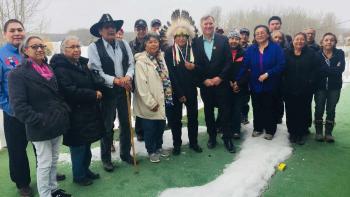Image Caption
Summary
By Shari Narine
Windspeaker Contributor
PAUL FIRST NATION, Alta.
“In the spirit of working together,” the Paul Band will be sharing with other First Nations what it learns on its way to bolstering its economy by investing in green energy.
“What we’re working on, starting from Day One with land designation and going through the process, we’re able to document and create a guidebook for other First Nations so they can follow the footsteps,” said Band councillor Aaron Bird.
Indigenous Relations Minister Richard Feehan announced last Thursday that the Paul Band would receive close to $750,000 through four of his department’s Indigenous climate leadership programs. Indigenous Relations has seven climate leadership programs geared to Indigenous governments and organizations and Feehan expects the Paul Band to receive future approval for the remaining three programs.
“Paul Band is really ahead of the curve on this,” said Feehan. “There are some pretty exciting developments in that community.”
The Paul Band will be following two simultaneous paths as it pursues green energy investment.
Close to $408,000 awarded through the Alberta Indigenous Green Energy Development Program will allow the First Nation to work on a business plan and the technical development stage programming for a 25 MW solar farm on land designated for an industrial park.
“The land designation was for an industrial park, but with coal phase-out we now realize there’s a better use for that industrial park,” said Bird.
In two years’ time, the band will have lost $1.8 million generated annually through TransAlta Utilities road and line permits and an impacts benefit agreement. To plan other economic opportunities, the Paul Band received $250,000 from the province in March through the Coal Community Transition Fund. It was the only First Nation to receive such funding.
For the solar farm to go ahead, community buy-in is needed, said Bird, who believes that may be as formal as a ratification vote.
The band has partnered with the national company Bird Construction (no relation to Aaron Bird) for development and, with community approval, construction could get underway next year. Initially, the energy produced will be used to meet on-reserve needs. However, additional land in the industrial park means the solar farm can expand and eventually sell power to the provincial grid.
“Throughout this year, while we’re planning, we’ll be waiting for more of the government initiatives to roll out with solar capacity,” said Bird.
Feehan said new rules will be coming next month for local area power generation.
“We’re looking at ways for … nations to start small and build up because we’d love as many nations as possible to get to the place where they can bid into the (Renewable Energy Program) system like a few of them are able to do right now. But many of them that’s just too much of a leap to get that far. What we’re doing is encouraging them to start (small),” said Feehan.
And also while the solar farm is in the planning stages, the Paul Band is talking to five developers about the First Nation becoming 25 per cent equity owners in wind farm development in southern Alberta. New Alberta Electric System Operator (AESO) rules do not limit a band to a single project or to working with a single developer, said Bird.
Indigenous participation in green energy development has been included as a requirement in the province’s second round in the Renewable Energy Program (REP2). However, REP3, which does not require Indigenous buy-in, is running alongside REP2.
Bird saix developers are interested in the partnership because “First Nations communities … have always been stewards of the land and this opportunity is just to support that stewardship.”
Paul First Nation is now in the financial stage of planning its equity, says Bird, and to that end, has joined the First Nations Finance Authority, which has “way cheaper” borrowing rates. Being accepted by FNFA is quite an accomplishment considering Paul First Nation only came out of 17 years of co-management earlier this year.
Investment through REP2 is a 20-year purchase agreement.
In the past two months, the Paul Band has received close to $1 million from the province.
That money, says Bird, is not replacing the coal dollars the Nation is losing nor does it mean that the band is now dependent on provincial funding.
“With the contributions that the government has given us, it helps us create a different path, a different future for our people. We were so reliant on those coal plants and now that they’re being phased out, this is our only opportunity to create that economic sovereignty that we need,” said Bird.
Federal funding has just become available for green energy projects and Feehan says bands are encouraged to look at that, too. He says provincial dollars will not be scaled back if a band is successful in attaining federal funding as well.
“Good bands are out there and they’re taking what they can from both sets of programs and putting them together in very complex systems and developing some pretty incredible forward-thinking projects,” said Feehan.

